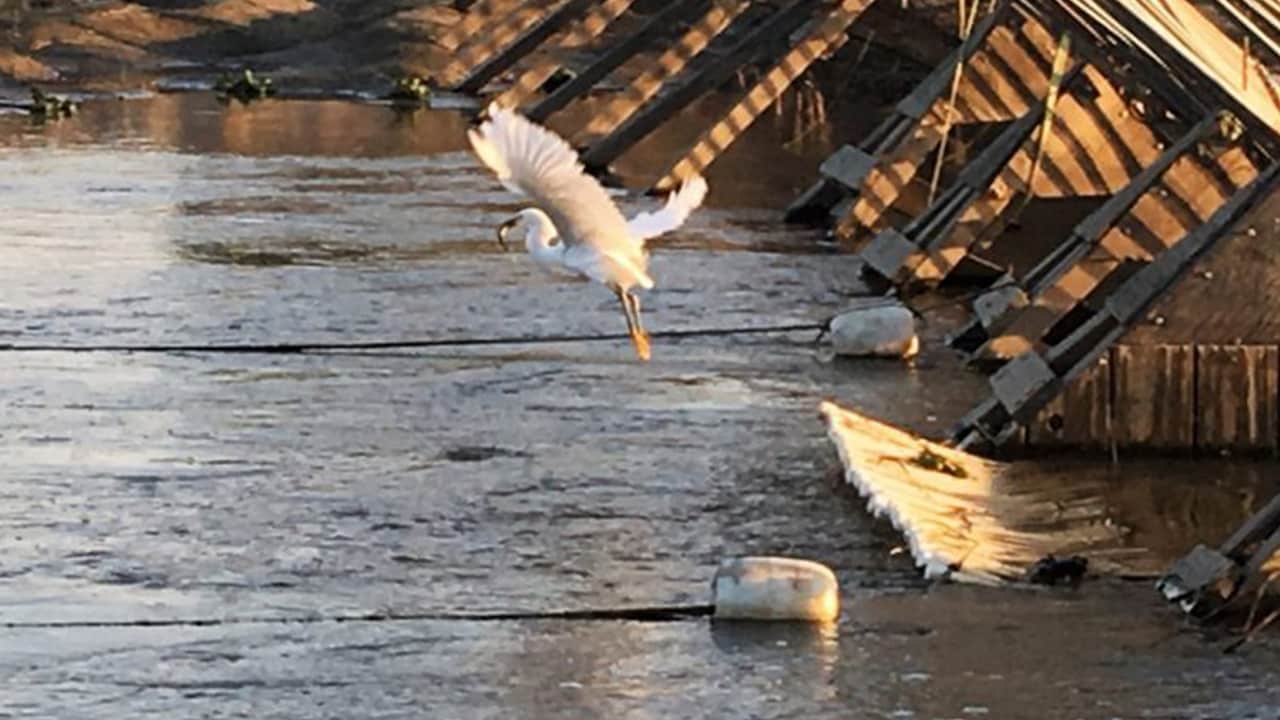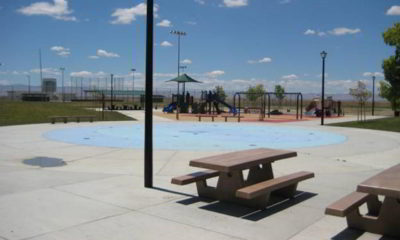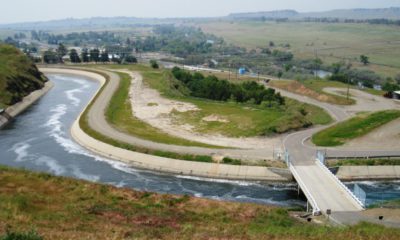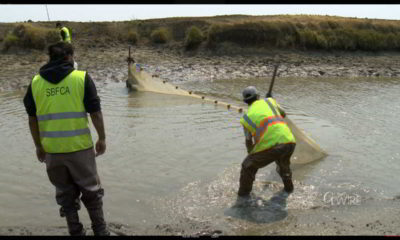Analysis
Westlands Again Is Eyeing San Joaquin River Water
Published
4 years agoon

Westlands Water District sent shockwaves through the Central Valley water world recently after it alerted several districts that it intends to apply for rights to flood flows on the San Joaquin River.
A previous attempt by Westlands to get rights to San Joaquin River water 20 years ago ignited a ferocious east-west battle in the valley that ended in failure for Westlands and left-east side farmers with a bitter taste and lingering suspicions.
This time around is different, said Tom Birmingham, general manager of the giant Westlands district, which covers most of western Fresno County.
While he expects news of Westlands’ intent to apply for flood water on the San Joaquin River to scratch at the scar of that old fight, he vowed that no existing water users would lose a drop of what they have now.
“This application is significantly different,” Birmingham said in reference to Westlands’ attempt to get river water back in 2000, which could have taken water from hundreds of farmers in Tulare and Kern counties.
“Our analysis indicates we can divert floodwater without injuring any other legal users. The point of our reaching out to the other districts is to assure them that any right Westlands may receive as a result of this application would be subordinate to their rights,” Birmingham said.
Westlands’ plan is to use those flood flows for groundwater recharge, something every water district is scrambling to do under the state’s new Sustainable Groundwater Management Act.
The Big Water Picture
He said Westlands’ pending application would be for 30,000 acre-feet to be taken out of the Mendota Pool but only when the river is flooding and after all other rights holders had been served. Westlands’ analysis suggests those conditions occur about every 10 years, he said.
When asked if 30,000 acre-feet are the maximum Westlands would take, Birmingham said that would depend on a number of circumstances including how long the river was flooding and whether water was available without harming senior rights holders.
“If the application is granted, the (State Water Resources Control) Board would establish conditions for the maximum Westlands could take,” he said.
Jason Phillips, general manager of the Friant Water Authority, which fought Westlands tooth and nail over its 2,000 application for San Joaquin River Water, was taking a cautious wait-and-see attitude.
“We have to see what’s in the application. But in the big picture, if water is being abandoned and going out to the ocean, I would rather see it kept in the valley for groundwater recharge,” he said. “I’m not in the camp of being opposed just because this is coming from Westlands.”
He wasn’t surprised by Westlands’ move as he and Birmingham had had some vague discussions about it in 2017, a massive flood year for the San Joaquin River.
Westlands had taken some floodwater off the river in 2017 under a permit held by the Bureau of Reclamation, which prompted a protest filing by Friant, Phillips said.
“I mentioned that if Westlands had its own permit, diversions of flood flows would be cleaner,” Phillips said. “If we can work something out, then great. But we have to see what’s actually filed.”
Birmingham said he also reached out to Chris White, Executive Director of the San Joaquin River Exchange Contractors but White did not return several calls from SJV Water.
[rlic_related_post_one]
Westlands Water District, which has some of the most productive farmland in the nation, has long struggled to secure a reliable water supply. (wwd.ca.gov)
Move Puts Friant Water Authority on High Alert
Though no one has seen Westlands’ application yet, the move has put Friant water managers on high alert.

“We have to see what’s in the application. But in the big picture, if water is being abandoned and going out to the ocean, I would rather see it kept in the valley for groundwater recharge. I’m not in the camp of being opposed just because this is coming from Westlands.” — Jason Phillips, general manager of Friant Water Authority
“Given the history, yes, this is a concern,” said Eric R. Quinley, General Manager of the Delano-Earlimart Irrigation District, which gets San Joaquin River water through the Friant-Kern Canal. “Friant Division Contractors, through the Bureau (of Reclamation) permits that are held in trust on behalf of those irrigators, absolutely must be served, bar none, without exception. Anything that crosses over the line and puts those contracts at risk is a concern.”
The details of Westlands’ application are important, particularly in regards to “Article 215” water, he said. The Bureau allocates 215 water to Friant contractors and others in high flow years.
Quinley wondered how Westlands’ application would affect that water.
“Last year, we took 10,000 acre-feet of 215 water in addition to our other contracted supply. Other Friant contractors have much larger 215 volumes. So access to the historical use of that water needs to remain available as well,” he said.
Because of a sag in the Friant-Kern Canal near Pixley caused by overpumping groundwater, however, the capacity to move large amounts of floodwater has been reduced by nearly half. That means southern water districts simply can’t get as much San Joaquin River floodwaters as they could if the canal were fully functional.
The cost to fix the canal has been estimated at about $400 million and a funding source has yet to be identified. Several bills are currently moving through Congress that could include money for the Friant-Kern Canal.
It did not escape some Friant water managers that Westlands, which has considerable political heft (former Westlands lobbyist David Bernhardt is now Secretary of Interior), could be a help or hindrance in obtaining that funding.
[rlic_related_post_two]Floodwater Fights
Meanwhile, Quinley noted, just about every agricultural water district in the valley is busy increasing its recharge capacity per SGMA.
So, competition for floodwaters on valley rivers has become downright fierce.
At least half a dozen groundwater sustainability plans up the valley, including Westlands, are claiming San Joaquin River high flow water for their SGMA recharge plans.
And it’s not just the San Joaquin.
In 2017, the Kings River Water Association filed a preemptive application with the State Water Board to head off a move by Semitropic Water Storage District in western Kern County for 1.6 million acre-feet of floodwater off the Kings River.
Semitropic’s application to the state Water Board states members of the Kings River Water Association aren’t using the flood water under their existing permit so that permit should be forfeited and given to Semitropic.
Kings River Water Association members argued they are building out their capture and recharge capabilities and, under SGMA, will need every drop of those floodwaters.

An aerial view of flooding on the San Joaquin River in April 2006. (midsjrfloodplan.org)
Saw It Coming
In anticipation of a similar move on San Joaquin River floodwaters by Westlands, the South Valley Water Association, made up of Friant contractors, put together a list of more than 60 projects that are either underway or will be shortly showing a use for almost all of the river’s floodwater.
That was done with Westlands in mind, said Dan Vink, Executive Director of the South Valley Water Association.
Rumblings that Westlands was preparing an application on the San Joaquin have been bubbling around the valley for about the past year, he said.
“There were a lot of discussions about water rights to high flows on the river during the Temperance Flat process,” Vink said. “Now that that’s mothballed, this shouldn’t be a surprise to anyone.
“They should have seen this coming.”
Temperance Flat is a long-proposed secondary dam above Millerton Lake that would capture high flow San Joaquin River Water that Millerton isn’t large enough to hold. It’s estimated to cost nearly $3 billion.
It lost steam in early 2019 when the California Water Commission only allotted $171 million to the project from Proposition 1 funding.
Dozens of Claims
Flood flows from the San Joaquin are, indeed, a part of Westlands’ groundwater sustainability plan, Birmingham confirmed.

“Our analysis indicates we can divert floodwater without injuring any other legal users. The point of our reaching out to the other districts is to assure them that any right Westlands may receive as a result of this application would be subordinate to their rights.” — Tom Birmingham, general manager, Westlands Water District
“This application would be a relatively minor element of our plan but an important element,” he said. “Everyone would agree, that in order to achieve sustainability of the groundwater basin, agencies need to take every feasible action and our analysis indicates this would be feasible without harming our neighbors of the environment.”
It’s unclear what all the claims to San Joaquin River flood flows for groundwater recharge may have on the attempt to revive the river, which had been dried up after the Friant Dam was built in the early 1950s.
Environmental groups that successfully sued to reclaim some water for the river back in 2006 have commented on a number of groundwater plans but are waiting to see Westlands’ application before making a statement, SJV Water was told.
Birmingham did not know when Westlands would submit its application to the State Water Board. A spokesman for the State Water Board confirmed it had not received any application for rights to the San Joaquin River from Westlands.
[rlic_related_post_three]Past River Fights
Westlands’ previous application for rights to San Joaquin River water in 2000 did not involve flood flows.
It was based on the theory that users in a river’s watershed of origin – in this case water users in Fresno and Madera counties – should be served before that river’s water could be shipped elsewhere.
About two-thirds of San Joaquin River water is moved south via the Friant-Kern Canal to farmers in Tulare and Kern counties.
Had Westlands prevailed, that could have dried up hundreds of thousands of acres.
The fight ended in a settlement under which Westlands signed over its application to the Friant Water Authority. The application remains, in stasis, at the State Water Board.
Friant hasn’t withdrawn it for fear another party might make a similar application and, under California water law, applications are considered on a first-in-time, first-in-right basis. Meaning, later applications aren’t given as high a priority.
When asked if Friant would file its own application for flood flows on the river as a preventative measure to Westlands’ or any other applications that might come along, Friant Water Authority’s Phillips said if it were to consider that action, he couldn’t comment publicly.
About SJV Water
SJV Water is a nonprofit, independent online news publication covering water in the San Joaquin Valley. Lois Henry is the CEO/Editor of SJV Water. She can be reached at lois.henry@sjvwater.org. The website is www.sjvwater.org.
Bill McEwen is news director and columnist for GV Wire. He joined GV Wire in August 2017 after 37 years at The Fresno Bee. With The Bee, he served as Opinion Editor, City Hall reporter, Metro columnist, sports columnist and sports editor through the years. His work has been frequently honored by the California Newspapers Publishers Association, including authoring first-place editorials in 2015 and 2016. Bill and his wife, Karen, are proud parents of two adult sons, and they have two grandsons. You can contact Bill at 559-492-4031 or at Send an Email

You may like
-


New Westlands Water District Board Member Appointed
-


Westlands Water District, Facing a Board Vacancy, Meets Tuesday to Discuss Options
-
Local Trump Supporters at Capitol Riots, Part of ‘Traitor’ Graham Confrontation
-


Water Agency’s Land Donation Will Benefit Mendota Park Expansion
-


Proposed Agreement Could Boost Funds To Fix Friant-Kern Canal
-


Zero Delta Smelt Found in Latest Search. New Habitat Hopes To Change That.













